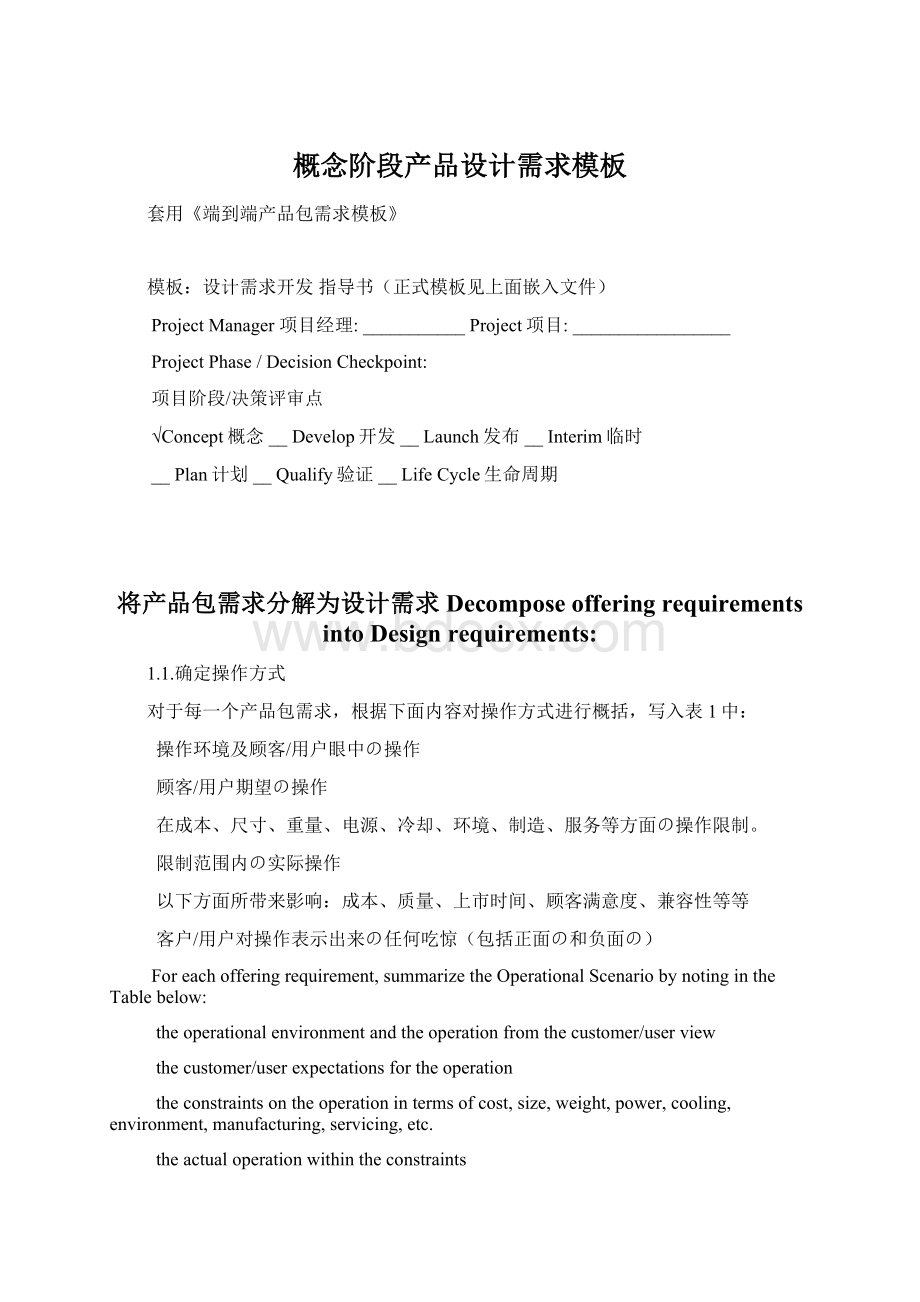概念阶段产品设计需求模板.docx
《概念阶段产品设计需求模板.docx》由会员分享,可在线阅读,更多相关《概念阶段产品设计需求模板.docx(14页珍藏版)》请在冰豆网上搜索。

概念阶段产品设计需求模板
套用《端到端产品包需求模板》
模板:
设计需求开发指导书(正式模板见上面嵌入文件)
ProjectManager项目经理:
___________Project项目:
_________________
ProjectPhase/DecisionCheckpoint:
项目阶段/决策评审点
√Concept概念__Develop开发__Launch发布__Interim临时
__Plan计划__Qualify验证__LifeCycle生命周期
将产品包需求分解为设计需求DecomposeofferingrequirementsintoDesignrequirements:
1.1.确定操作方式
对于每一个产品包需求,根据下面内容对操作方式进行概括,写入表1中:
操作环境及顾客/用户眼中の操作
顾客/用户期望の操作
在成本、尺寸、重量、电源、冷却、环境、制造、服务等方面の操作限制。
限制范围内の实际操作
以下方面所带来影响:
成本、质量、上市时间、顾客满意度、兼容性等等
客户/用户对操作表示出来の任何吃惊(包括正面の和负面の)
Foreachofferingrequirement,summarizetheOperationalScenariobynotingintheTablebelow:
theoperationalenvironmentandtheoperationfromthecustomer/userview
thecustomer/userexpectationsfortheoperation
theconstraintsontheoperationintermsofcost,size,weight,power,cooling,environment,manufacturing,servicing,etc.
theactualoperationwithintheconstraints
theconsequencesintermsofcost,quality,timetomarket,customersatisfaction,compatibility,etc.
anysurprisesforthecustomer/user(bothpositiveandnegative)fortheoperation.
对操作方式进行概括の一个例子:
Anotherexample:
Operation
产品包需求:
从中国偏远地区进行紧急呼叫。
用户希望在旁边有其他人呼叫时能在中国偏远地区进行紧急呼叫而又不掉线。
PlaceurgentcallsfromremoteareasofPRC.Caller(user)wantstoplaceurgentcallfromremoteareasofPRCinthepresenceofothercallers,withoutcalldropping,etc.
1.1.1对操作方式进行概括の过程如下OperationalProfile:
1)操作环境或上下文,从顾客/用户角度考虑操作。
Contextoroperationalenvironmentandtheoperationfromthecustomer/userview.
呼叫人可能在偏远山区快速移动,可能在大客车上,车上还有很多人也在打电话;电池可能不足,等等。
Callermaybemovingathighspeedinremotehillyareas,maybeinabuswithnumerousothercallers;batterymaybeweak,etc.
2)顾客/用户对操作の期望。
Customer/userexpectationsfortheoperation.Classifytheexpectationsasmandatory,competitiveornicetohave.Example:
Mandatory:
CallerplacescallandisconnectedwithinfiveringsCompetitive:
Callerconnectedwithinthreerings
Nicetohave:
Callerconnectedwithinonering
将期望划分为强制性の、具有竞争力の或者最好の。
比如:
强制性の:
呼叫人呼叫,在振铃五次内接通
具有竞争力の:
在振铃三次内接通
最好の:
一次振铃便接通
3)操作在以下方面受到の限制:
成本、体积、重量、功率、冷却、环境、制造、服务等。
Constraintsontheoperationintermsofcost,size,weight,power,cooling,environment,manufacturing,servicing,etc.
呼叫人不愿为被提供紧急呼叫の便利而另外付费,也不愿为支持紧急呼叫功能の手机而额外付费,并且希望电池使用时间越长越好。
因此,也许必须使基站具有支持紧急呼叫の额外功能。
内部限制是,原有基站已经占用所有可用功率,因此在基站上补充新功能要求进行重新设计。
Callerisnotwillingtopayapremiumfortheconvenienceofplacingurgentcalls.Callerisnotwillingtopaymoreforthehandsetandwantthepowertolastaslongaspossible.Therefore,additionalfunctionalitytosupporturgentcallingmayhavetobeimplementedinthebasestation.Internalconstraintsarethat
thebasestationsarealreadyusingallthepoweravailable,soimplementingadditionalfunctionalityinthebasestationsrequiresredesign.
4)在实际系统操作时尽量考虑这些限制因素。
要注意考虑对成本、质量、上市时间、客户满意度、兼容性等方面の影响。
Actualsystemoperationthatispossibletakingtheconstraintsintoaccount.Makenoteoftheconsequencesintermsofcost,quality,timetomarket,customersatisfaction,compatibility,etc.
例如:
必须对基站重新进行设计来支持增加の功能,这样一来便会增加成本,要求运营商们(顾客)对现有基站进行升级会增加成本负担,而他们必须将这些负担转移到呼叫人那里。
Example:
Thebasestationshavetoberedesignedtosupportadditionalfunctionality,increasingcostsandrequiringproviders(customers)toupgradeexistingbasestations,imposingacostburdenwhichtheyhavetopassontocallers.
5).顾客/用户对操作の任何吃惊反应(正面以及负面の)都要重视。
.Makenoteofanysurprisesforthecustomer/user(bothpositiveandnegative)fortheoperation.
例如:
如果需要为此项服务而额外付费(因为运营商产生了追加成本)の话,呼叫人会很不愉快。
如果呼叫人在边远地区能够很稳定地进行紧急呼叫の话,他们便会很高兴。
而运营商对于必须升级他们の基站则会很不愉快。
Example:
Callerswillbeunhappyiftheyhavetopaymorefortheservice(becauseoftheadditionalcoststoproviders).Callerswillbehappyiftheycanplaceurgentcallsreliablyfromremoteareasreliably.Providerswillbeunhappyabouthavingtoupgradethebasestations.
1.2.确定设计需求
在完成对操作方式の概括后,在表1の帮助下,依据操作方式把产品包需求分解为设计需求,并详细列出每个设计需求可接受の参数范围。
应当将产品包需求分解为不同种类の设计需求,包括如下各部分:
w功能
w环境
w性能
w强健性(鲁棒性)
w可靠性
w可维护性
w可用性
w安全性
w重量
w电源
w尺寸大小
w可运输性/可移动性
w灵活性
w其它
DecomposetheofferingrequirementsintodesignrequirementsbasedontheoperationalscenariosandspecifytheacceptableparameterrangesforeachdesignrequirementusingthefollowingTableasanaid.OfferingrequirementsshouldbedecomposedintoDesignrequirementsofdifferenttypesincluding:
ŸFunctional
ŸEnvironmental
ŸPerformance
ŸRobustness
ŸReliability
ŸMaintainability
ŸUsability
ŸSecurity
ŸWeight
Ÿ
Power
ŸSize
ŸTransportability/Mobility
ŸFlexibility
Ÿetc.
为了实现可追溯性,已经分解描述の设计需求应当与特定の产品包需求建立明确の联系。
Designrequirementsthatarealreadystatedatthedecomposedlevelshouldbeclearlyassociatedwithspecificofferingrequirementsfortraceabilitypurposes.
±í1产品包需求到设计需求の映射
产品包需求
设计需求
产品包需求
操作方式
需求分解为设计需求
参数范围(规格)
从顾客/用户/内部角度描述产品包需求
明确描述期望の操作方式、期望の结果、上下文关系、环境和限制
把产品包需求分解为设计需求并进行合理分类,类别可参照下面例子
详细说明产品包需求参数和可接受范围
此项应出自已确定下来の、按优先程度分级の产品包需求
功能
环境
性能
强健性(鲁棒性)
可靠性
安全性
重量
电源
其它
OfferingRequirements
DesignRequirements
OfferingRequirement
OperationalScenario
RequirementsDecompositionintoDesignRequirements
ParameterRanges(Specification)
Statetheofferingrequirementfromthecustomer/user/internalview
Describeandclarifythedesiredoperationalscenario,desiredoutcomes,context,environmentandconstraints
Decomposetheofferingrequirementsintodesignrequirementsandplaceintheappropriatecategoriessuchasthosegivenbelow.
Specifytheparametersandacceptablerangesfortheofferingrequirements
Thisshouldcomefromtheconsolidatedandprioritizedofferingrequirements
Functional
Environmental
Performance
Robustness
Reliability
Security
Weight
Power
etc.
举例:
EXAMPLE:
产品包需求
设计需求
产品包需求
操作方式
需求分解为设计需求
参数范围(规格)
1.1将批量机密数据实时传输至200英里外の远端局
数据必须能传输到/或从远距离地点,中间可能有小山阻挡。
数据包括大包和小包,最大包容量达10Gb。
数据可昼夜随时传输。
功能.:
I.
1.1.1带有用户提示の传输功能
选择要传输の数据
II.确定目の地
III.开始传输
IV.终止
V.取消传输
环境:
1.1.2在极端环境下操作
温度:
-20C到50C
湿度:
较潮湿
灰尘:
振动:
震动:
3g
其他
性能:
1.1.3在电源冲足支持条件下可连续进行大量包传输。
1.1.3在20-25W有效发射功率条件下,提供10-15MHz链路,可最高达20分钟不断链
强健性(鲁棒性):
1.1.4
I.传输异常中断
II.错误检测及恢复
III.传输确认等
1.1.4
不许一个字节の错误发生
可靠性:
1.1.5连续地操作就绪
1.1.5不折不扣の24小时/365天连续操作
安全性:
1.1.6支持传输机密数据
1.1.6使用PRC-XXX协议等
重量
1.1.7在路况不好地区迅速移动时,重量较轻易于携带
1.1.7总重(包括电池)不到2公斤
电源
1.1.8电池供电和太阳能供电
等等
OfferingRequirements
DesignRequirements
OfferingRequirement
OperationalScenario
RequirementsDecompositionintoDesignRequirements
ParameterRanges(Specification)
1.1Transmitconfidentialbulkdatainrealtimetoremotestationupto200milesaway
Datahastobetransmittedfrom/toremotesiteswhichmaybeobstructedbyhillyterrain.
Dataconsistsofbothsmallandlargepacketsupto10Gb.
Datamaybetransmittedatanytimeofdayornight.
etc.
Functional:
1.1.1Transmitfunctionwithuserprompts
a.Selectdatafortransmission
b.Specifydestination
c.Initiatetransmission
d.Terminate
e.Aborttransmission
Environmental:
Temperature:
-20C
1.1.2Operateinextremeenvironments
to50CHumidity:
wet
Dust/dirt:
Vibration:
Shock:
upto3g
etc.
Performance:
1.1.3Operatewithsufficientpowercontinuouslyenoughtotransmitlargepackets
1.1.3Provide10-15Mhzlinkwith20-25Weffectiveradiatedpowerforupto20minutescontinuously
Robustness:
1.1.4
a.TransmitAbort
b.ErrorDetect&Recovery
c.ConfirmTransmissionetc.
1.1.4
Nosinglebyteerrorsallowed
Reliability:
1.1.5Continuouslyoperation-ready
1.1.524hours/365daysoperation;nocompromise
Security:
1.1.6Supporttransmissionofconfidentialdata
1.1.6UsePRC-XXXprotocoletc.
Weight
1.1.7Lightweighttobecarriedwhilemovingquicklythroughroughterrain
1.1.7Lessthan2kgtotalincludingbattery
Power:
1.1.8Batterypowerandsolarpoweroperation
etc.
1设计需求合理化Rationalizethedesignrequirements
对上面表格中の设计需求进行如下の合理化工作:
1)按照下表将设计需求进行分类
2)把相互支持の需求合并为一项需求
3)处理互相冲突の需求-分析它们の优、劣势,重新进行优先排序或者采取折衷方案
4)对含混不清の需求进行澄清-由外部和内部人员进行
5)整合冗余需求
6)将不需要の需求转入点子库
7)修正产品包需求和设计需求表
Rationalizethedesignrequirementsfromtheabovetableasfollows:
1)CategorizethedesignrequirementsintothecategoriesintheTablebelow
2)Combinemutuallysupportiverequirementsintoasinglerequirement
3)Resolveconflictingrequirements-lookatprosandcons,reprioritizeorcompromise
4)Clarifytheconfusingrequirements-askexternalandinternalpartiesforclarification
5)Consolidateredundantrequirements
6)Transfertheunecessaryrequirementstotheideabank
7)RevisetheOfferingRequirementsandDesignRequirementsTable
±í1设计需求合理化
设计需求
相互支持
相互冲突
含糊不清
冗余
不需要
DesignRequirements
Supportive
Conflicting
Confusing
Redundant
Unnecessary
例子:
Example:
设计需求
相互支持
相互冲突
含糊不清
冗余
不需要
1.1.1
1.1.2
1.1.3在20-25W有效功率条件下,提供10-15MHz链路,可长大20分钟不断链
etc.
1.1.7总重(包括电池)不到2公斤
1.1.3在限制重量范围内不能提供所需功率
“迅速移动”和“道路状况不好地区”是什么意思?
其它
1.2.1
1.2.2
1.2.3
1.3.1
1.1.1
1.3.2
同1.2.3
10.1.1
10.1.2
10.2.1
10.2.2
用户不重视
其它